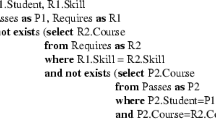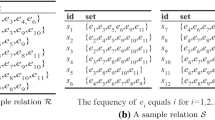Abstract
In this paper, we study the problem of set containment join. Given two collections \(\mathcal {R}\) and \(\mathcal {S}\) of records, the set containment join \(\mathcal {R} \bowtie _\subseteq \mathcal {S}\) retrieves all record pairs \(\{(r,s)\} \in \mathcal {R}\times \mathcal {S}\) such that \(r \subseteq s\). This problem has been extensively studied in the literature and has many important applications in commercial and scientific fields. Recent research focuses on the in-memory set containment join algorithms, and several techniques have been developed following intersection-oriented or union-oriented computing paradigms. Nevertheless, we observe that two computing paradigms have their limits due to the nature of the intersection and union operators. Particularly, intersection-oriented method relies on the intersection of the relevant inverted lists built on the elements of \(\mathcal {S}\). A nice property of the intersection-oriented method is that the join computation is verification free. However, the number of records explored during the join process may be large because there are multiple replicas for each record in \(\mathcal {S}\). On the other hand, the union-oriented method generates a signature for each record in \(\mathcal {R}\) and the candidate pairs are obtained by the union of the inverted lists of the relevant signatures. The candidate size of the union-oriented method is usually small because each record contributes only one replica in the index. Unfortunately, union-oriented method needs to verify the candidate pairs, which may be cost expensive especially when the join result size is large. As a matter of fact, the state-of-the-art union-oriented solution is not competitive compared to the intersection-oriented ones. In this paper, we propose a new union-oriented method, namely TT-Join, which not only enhances the advantage of the previous union-oriented methods but also integrates the goodness of intersection-oriented methods by imposing a variant of prefix tree structure. We conduct extensive experiments on 20 real-life datasets and synthetic datasets by comparing our method with 7 existing methods. The experiment results demonstrate that TT-Join significantly outperforms the existing algorithms on most of the datasets and can achieve up to two orders of magnitude speedup. Furthermore, to support large scale of datasets, we extend our techniques to distributed systems on top of MapReduce framework. With the help of careful designed load-aware distribution mechanisms, our distributed join algorithm can achieve up to an order of magnitude speedup than the baselines methods.























Similar content being viewed by others
Notes
Algorithm 1 is named RI-Join in this paper since there is no index on \(\mathcal {R}\) and an inverted index is built on \(\mathcal {S}\).
The new simple union-oriented method is named IS-Join because an inverted index is built on \(\mathcal {R}\) and there is no index on \(\mathcal {S}\).
References
http://www.cim.mcgill.ca/~dudek/206/Logs/AOL-user-ct-collection
http://www.dtic.upf.edu/~ocelma/MusicRecommendationDataset/lastfm-1K.html
Afrati, F.N., Sarma, A.D., Menestrina, D., Parameswaran, A., Ullman, J.D.: Fuzzy joins using mapreduce. In: ICDE, pp. 498–509 (2012)
Agrawal, P., Arasu, A., Kaushik, R.: On indexing error-tolerant set containment. In: SIGMOD, pp. 927–938 (2010)
Arasu, A., Ganti, V., Kaushik, R.: Efficient exact set-similarity joins. In: VLDB, pp. 918–929 (2006)
Baeza-Yates, R., Salinger, A.: A fast set intersection algorithm for sorted sequences. In: CPM (2004)
Bayardo, R.J., Ma, Y., Srikant, R.: Scaling up all pairs similarity search. In: WWW, pp. 131–140 (2007)
Bouros, P., Mamoulis, N., Ge, S., Terrovitis, M.: Set containment join revisited. In: Knowledge and Information Systems, pp. 1–28 (2015)
Chaudhuri, S., Ganti, V., Kaushik, R.: A primitive operator for similarity joins in data cleaning. In: ICDE (2006)
Deng, D., Li, G., Hao, S., Wang, J., Feng, J.: Massjoin: a mapreduce-based method for scalable string similarity joins. In: ICDE, pp. 340–351 (2014)
Deng, D., Li, G., Wen, H., Feng, J.: An efficient partition based method for exact set similarity joins. In: VLDB, pp. 360–371 (2015)
Han, J., Pei, J., Yin, Y.: Mining frequent patterns without candidate generation. In: SIGMOD, pp. 1–12 (2000)
Helmer, S., Moerkotte, G.: Evaluation of main memory join algorithms for joins with set comparison predicates. In: VLDB, pp. 386–395 (1997)
Hmedeh, Z., Kourdounakis, H., Christophides, V., Du Mouza, C., Scholl, M., Travers., N.: Subscription indexes for web syndication systems. In: EDBT, pp. 312–323 (2012)
Hu, X., Tao, Y., Yi, K.: Output-optimal parallel algorithms for similarity joins. In: PODS, pp. 79–90 (2017)
Jampani, R., Pudi, V.: Using prefix-trees for efficiently computing set joins. In: DASFAA, pp. 761–772 (2005)
Kunkel, A., Rheinländer, A., Schiefer, C., Helmer, S., Bouros, P., Leser, U.: Piejoin: towards parallel set containment joins. In: SSDBM, p. 11 (2016)
Leskovec, J., Backstrom, L., Kleinberg, J.: Meme-tracking and the dynamics of the news cycle. In: SIGKDD, pp. 497–506 (2009)
Li, C., Lu, J., Lu, Y.: Efficient merging and filtering algorithms for approximate string searches. In: ICDE, pp. 257–266 (2008)
Luo, Y., Fletcher, G.H., Hidders, J., De Bra, P.: Efficient and scalable trie-based algorithms for computing set containment relations. In: ICDE, pp. 303–314 (2015)
Mamoulis, N.: Efficient processing of joins on set-valued attributes. In: SIGMOD, pp. 157–168 (2003)
Mann, W., Augsten, N., Bouros, P.: An empirical evaluation of set similarity join techniques. In: VLDB, pp. 636–647 (2016)
Melnik, S., Garcia-Molina, H.: Divide-and-conquer algorithm for computing set containment joins. In: EDBT, pp. 427–444 (2002)
Melnik, S., Garcia Molina, H.: Adaptive algorithms for set containment joins. TODS 28(1), 56–99 (2003)
Metwally, A., Faloutsos, C.: V-smart-join: a scalable mapreduce framework for all-pair similarity joins of multisets and vectors. In: VLDB, pp. 704–715 (2012)
Ramasamy, K., Patel, J.M., Naughton, J.F., Kaushik, R.: Set containment joins: the good, the bad and the ugly. In: VLDB, pp. 351–362 (2000)
Sun, J., Shang, Z., Li, G., Dend, D., Bao, Z.: Dima: a distributed in-memory similarity-based query processing system. In: VLDB, pp. 1925–1928 (2017)
Terrovitis, M., Bouros, P., Vassiliadis, P., Sellis, T., Mamoulis, N.: Efficient answering of set containment queries for skewed item distributions. In: EDBT, pp. 225–236 (2011)
Terrovitis, M., Passas, S., Vassiliadis, P., Sellis, T.: A combination of trie-trees and inverted files for the indexing of set-valued attributes. In: CIKM, pp. 728–737 (2006)
Vernica, R., Carey, M.J., Li, C.: Efficient parallel set-similarity joins using mapreduce. In: SIGMOD, pp. 495–506 (2010)
Wang, J., Feng, J., Li, G.: Trie-join: Efficient trie-based string similarity joins with edit-distance constraints. In: VLDB, pp. 1219–1230 (2010)
Wang, J., Li, G., Feng, J.: Can we beat the prefix filtering? An adaptive framework for similarity join and search. In: SIGMOD, pp. 85–96 (2012)
Wang, X., Qin, L., Lin, X., Zhang, Y., Chang, L.: Leveraging set relations in exact set similarity join. In: VLDB, pp. 925–936 (2017)
Xiao, C., Wang, W., Lin, X., Shang, H.: Top-k set similarity joins. In: ICDE, pp. 916–927 (2009)
Xiao, C., Wang, W., Lin, X., Yu, J.X.: Efficient similarity joins for near duplicate detection. In: WWW, pp. 131–140 (2008)
Yan, T.W., García-Molina, H.: Index structures for selective dissemination of information under the boolean model. TODS 19(2), 332–364 (1994)
Zhu, E., Nargesian, F., Pu, K.Q., Miller, R.J.: LSH ensemble: Internet scale domain search. In: VLDB, pp. 1185–1196 (2016)
Acknowledgements
Ying Zhang is supported by ARC FT170100128 and DP180103096. Wenjie Zhang is supported by ARC DP180103096. Xuemin Lin is supported by NSFC 61672235, DP170101628, and DP180103096. Shiyu Yang is sponsored by Shanghai Sailing Program.
Author information
Authors and Affiliations
Corresponding author
Additional information
The work was partly done when the author was studying in the University of New South Wales.
Rights and permissions
About this article
Cite this article
Yang, J., Zhang, W., Yang, S. et al. Efficient set containment join. The VLDB Journal 27, 471–495 (2018). https://doi.org/10.1007/s00778-018-0505-x
Received:
Revised:
Accepted:
Published:
Issue Date:
DOI: https://doi.org/10.1007/s00778-018-0505-x




